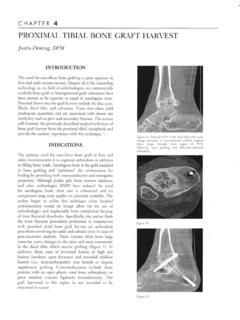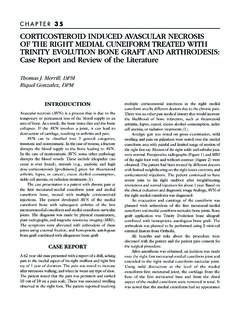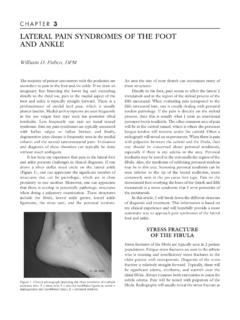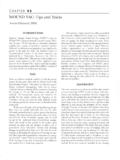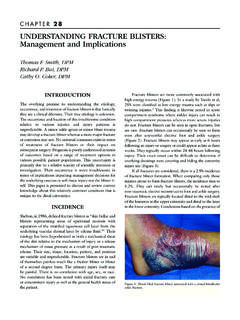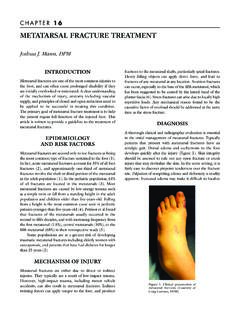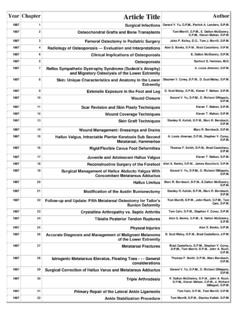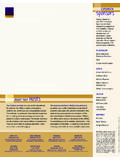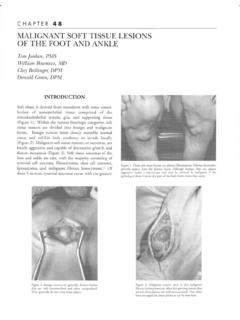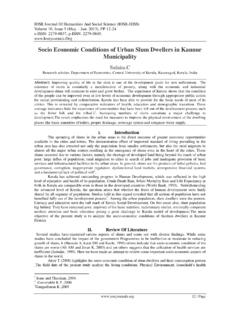Transcription of PARTIAL CALCANECTOMY - The Podiatry Institute
1 CHAPTER 13. PARTIAL CALCANECTOMY . Thomas A. Brosky II, DPM. Cameron Eilts, DPM. INTRODUCTION level <3 g/dl. Wound classification also was a very strong predictor for healing. The Wagner wound classification Heel ulceration with osteomyelitis has become an was used to grade the wounds: of Wagner 2 wounds unfortunate and common finding in the lower extremity healed in 1 year as compared with of Wagner 3. specialist's patient population. Many statistics have been wounds. Of note, they found some factors to bear no published to project the high incidence of diabetes and influence on healing body mass index and the wound age peripheral vascular disease ( of the current US before surgery did not seem to affect the healing rate.)
2 Population has diabetes).1 It is estimated that 30% of the Finally, patients with a history of smoking had similar adult population in the US has some form of peripheral closure rates, but it took longer for them to close vascular Perhaps the most serious evidence of the their importance of limb salvage was demonstrated in 2004 by In a study by Bollinger and Thordarson, they success- Aulivola et They found the survival rates of patients with fully healed all wounds without the need for below knee concurrent diabetes or renal disease who underwent major amputation. However, 11 additional procedures were amputations to be 70% at one year and only 30% at 5 performed in 9 patients; 5 for soft tissue debridement, 3 for years.
3 This data, combined with other studies looking at exostosis removal and 1 for skin grafting. Maybe not cardiac stress from leg amputation4,5 lead one to objective surprisingly, all 9 of their patients with diabetes had delayed information towards limb salvage. wound healing compared with those without diabetes. They PARTIAL CALCANECTOMY (PC) can be an alternative to leg also found two technical details concerning the surgical amputation under the appropriate conditions. In the procedure: ulcers >7 cm would not allow for a tension-free largest series of PC, Cook et al produced a variety of data closure, and casting in plantar flexion for a minimum of 4. in their study demonstrating how each case is unique, weeks should be performed after though certain trends were A number of other smaller studies have looked at We will review PREOPERATIVE EXAMINATION.
4 The current literature and discuss the senior author's preoperative planning and preferred surgical technique. AND TESTING. The most important aspect of the preoperative process is LITERATURE REVIEW the clinical and medical status of the patient. These patients often have comorbid conditions that need PARTIAL CALCANECTOMY has been extensively reviewed in the attention by multiple specialties. The decision for a PARTIAL literature, however no studies exist other than case reports CALCANECTOMY must also take into account the patient's or In the largest and perhaps most valuable expectations as well as eradication of any acute infectious study to date, Cook et al discussed that there are multiple process. PARTIAL CALCANECTOMY can be an excellent option factors that effect healing rates.
5 Vascular disease, albumin prior to leg amputation because the latter procedure will levels, MRSA infections, and preoperative ulcer grade all not be compromised. had a significant influence on patient outcomes. Twenty- Imaging for the determination and location of eight of 46 patients required vascular intervention before osteomyelitis is beyond the scope of this paper, but a few PC, and had a slightly lower closure rate. Closure rate in tests should be mentioned. Imaging modalities will always patients who produced MRSA isolates had a 50% closure start with plain films, which will often demonstrate some rate, compared with 71% for the non-MRSA patients. type of bone involvement, especially in long-standing They also found protein nutritional status to be a ulcerations.
6 The lateral view may be all that is necessary, significant factor. A serum albumin level >3 g/dl healed but routine views are recommended in order to rule out 69% of the time compared with 56% for patients with a multiple areas of infection. Magnetic resonance imaging 86 CHAPTER 13. (MRI) is a useful tool to rule out soft tissue pathology and often necessary with the possibility of long-term intravenous determine the extent of bone involvement. Computed antibiotics. tomography scan is another useful tool for determination Preoperative radiographs, MRI, bone scans, etc. along of bone quality, but is less sensitive for soft tissue with wound presentation and vascular status will destruction. Leukocyte-labeled bone scans may also be help- determine the extent of bony and deep tissue involvement ful to rule out Charcot neuroarthopathy from osteomyelitis.
7 And eventual incision location. Surgical incision location Of utmost importance is consultation with a vascular and shape can depend on several factors, but generally a surgeon. At the minimum, noninvasive vascular studies direct linear posterior or posterior medial approach can be should be obtained to determine healing potential. used. Another option is the extensile hockey-stick Any intervention beyond this can be determined by the posterior-lateral approach that provides much more vascular team. Other consultations will be obtained exposure. It is obviously useful if the patient can be in the depending on the patient's comorbidities, including prone position for this procedure. If not, due to internal medicine, nephrology, and infectious disease.
8 Anesthesia concerns, a lateral position with use of a Nutrition specialists are routinely consulted due to this vacuum bean-bag can be used. Any ulceration or population's poor glycemic control as well as their overall nonviable tissue can be excised in a semi-elliptical fashion. poor nutritional health. When planning the incision, care should be taken to Since smoking plays a key role in the overall success maintain the skin flaps in full thickness, without rates, the authors routinely enter into a contract with the undermining the subcutaneous tissue (Figure 1). The skin patient. The patients are randomly tested for nicotine and should also be handled delicately with minimal use of cotinine levels prior to surgery. The patient is educated on retractors.
9 The clinical appearance of the soft tissue and these facts and understands that if they test positive, the bone is the most useful guide to determine the extent of procedure is never undertaken. The authors have found tissue resection. The use of a tourniquet is often avoided this method to be successful in these patients with chronic to aid in the identification of bleeding, healthy tissue. conditions. The Achilles tendon will be detached and any nonviable portions resected. It is important to maintain PATIENT AND length for reattachment to the calcaneus. Once the soft tissue is fully dissected free from the calcaneus, power and FAMILY EDUCATION. hand instrumentation is used to remove the posterior Preoperative planning should begin with patient and calcaneus at an angle from posterior-proximal to plantar- family education and a clear understanding of their distal, taking care to remove all nonbleeding bone, but expectations.
10 We strongly recommend a discussion on this leaving enough to reattach the Achilles tendon. The being a salvage procedure and leg amputation can still amount of calcaneus is typically one-half to two-thirds of occur. Also, permanent bracing with a custom shoe may be the calcaneal body, but will ultimately be determined by needed for a lifetime. Further surgery for debridement is the clinical picture (Figure 2). Figure 1. Preoperative incision placement to excise ulceration. Figure 2. Resection of posterior half of calcaneal body. CHAPTER 13 87. Figure 3A. Many options exist for reattachment of Achilles tendon. Figure 3B. Options for reattachment of Achilles tendon. Figure 4. In this case, closure was delayed and a Wound VAC was applied.
